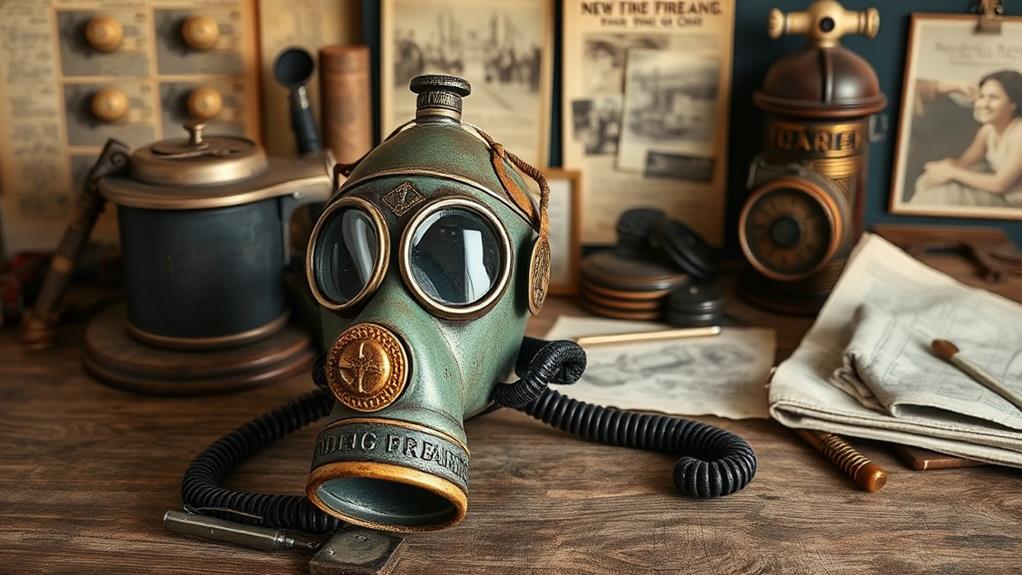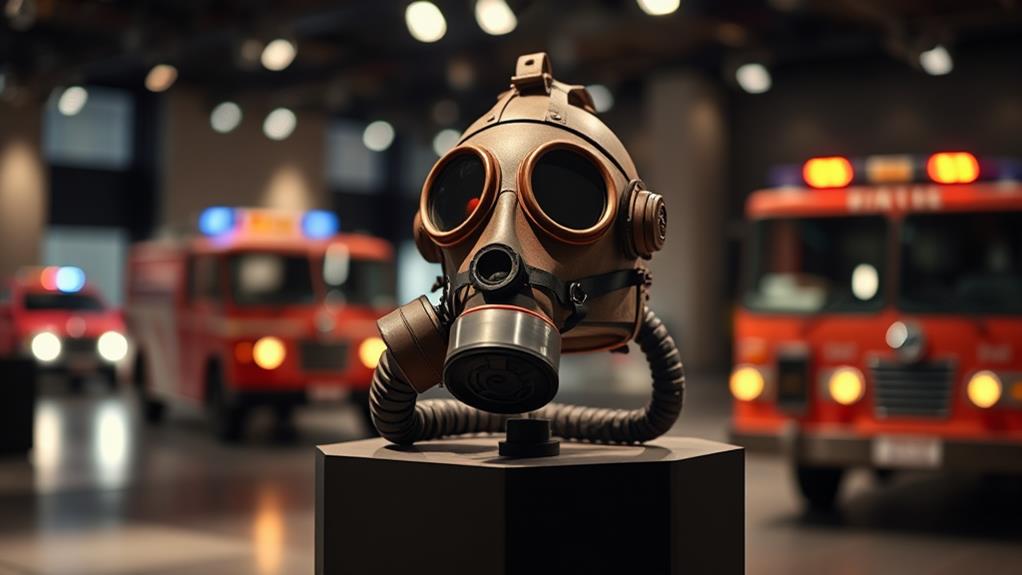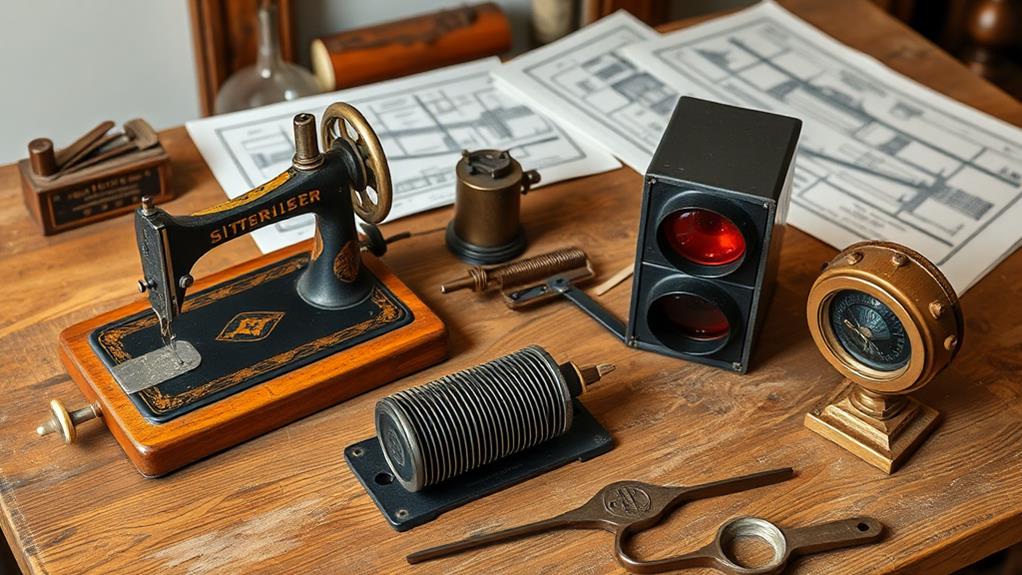Interesting Facts About Garrett Morgan’s Inventions
Garrett Morgan's inventions showcased his innovative spirit and commitment to safety. You might know about his three-position traffic signal, which added a "caution" light to reduce accidents. But did you know he also invented a gas mask that saved lives during the Cleveland Waterworks explosion? His safety hood, patented in 1914, was a precursor to modern respiratory protection. Morgan's creativity extended to hair care, too. He accidentally discovered a hair straightener while working on sewing machines, leading to a successful business venture. These inventions, along with his lesser-known mechanical creations, demonstrate Morgan's versatility and problem-solving skills. There's more to uncover about this prolific inventor's contributions to society.
This post may contain affiliate links. If you make a purchase through these links, I may earn a commission at no additional cost to you. Additionally, portions of this post may be generated using artificial intelligence (AI) technology. While we strive for accuracy, please be aware that AI-generated content may not always be perfect and should be fact-checked when necessary.
The Spatula Scoops
- Morgan's safety hood, patented in 1914, was inspired by the Triangle Shirtwaist Factory fire and saved lives during the Cleveland Waterworks explosion.
- His three-position traffic signal, patented in 1923, added a "caution" light and was sold to General Electric for $40,000.
- Morgan accidentally discovered a hair straightener while experimenting with sewing machine chemicals, leading to a successful hair care business.
- The gas mask he developed was adapted for U.S. troops in World War I to protect against chemical warfare.
- Despite racial biases limiting initial sales, Morgan's safety hood earned international recognition and a gold medal in 1914.
The Safety Hood's Unexpected Origins

You might be surprised to learn that one of Garrett Morgan's most famous inventions, the Safety Hood, was born out of tragedy. The devastating Triangle Shirtwaist Factory fire in 1914 highlighted the urgent need for better smoke protection for both rescuers and victims. This event inspired Morgan to create a breathing device that would revolutionize safety practices.
Morgan's Safety Hood was designed with a tube that allowed users to breathe cleaner air from outside, making it an early predecessor to modern gas masks. The invention's life-saving potential became evident during the Cleveland Waterworks explosion in 1916. Morgan and his brother used the Safety Hood to rescue trapped workers, successfully saving two lives and garnering national attention.
Despite its innovative design and proven effectiveness, the Safety Hood faced challenges in gaining widespread acceptance. Racial biases of the time limited its commercial success during Morgan's lifetime, impacting initial sales and adoption. However, the invention's significance was recognized internationally, earning Morgan a gold medal at the Second International Exposition of Safety and Sanitation in 1914.
Traffic Signal's Three-Position Innovation

While the Safety Hood made waves in fire safety, it's Garrett Morgan's traffic signal that continues to shape our daily lives. You might not realize it, but every time you approach an intersection, you're benefiting from Morgan's ingenious invention. On November 20, 1923, he patented the three-position traffic signal, introducing a vital "caution" light that revolutionized road safety.
Before Morgan's innovation, traffic signals only had "Stop" and "Go" indicators, leading to numerous accidents and confusion among drivers and pedestrians. His design added a third position, allowing for clearer communication of traffic flow. This greatly reduced the risk of collisions and injuries at busy intersections.
Morgan's impact on urban planning and road safety regulations is undeniable. He sold the rights to his traffic signal patent to General Electric for $40,000, paving the way for the development of electric traffic signals across North America. Today, his three-position concept remains integral to modern traffic management systems, influencing how cities design and control traffic flow. Morgan's invention continues to save lives and improve efficiency on roads worldwide.
Hair Straightener's Accidental Discovery

Garrett Morgan's inventive spirit extended far beyond traffic signals. You might be surprised to learn that he accidentally discovered a hair straightener in 1905 while experimenting with chemical combinations for sewing machines and fabrics. This accidental discovery led to a patented hair straightening formula in 1913, which became the foundation for the G.A. Morgan Hair Refining Company.
Morgan's hair straightener quickly gained popularity within the African American community. It provided a safer alternative to existing products, which often contained harmful ingredients. This invention not only addressed a need for effective hair styling methods but also created significant business opportunities and self-employment avenues for many.
The success of Morgan's hair straightener demonstrates his adaptability and inventive nature. He skillfully applied his mechanical expertise to personal care products, showcasing his versatility as an inventor. This accidental discovery turned into a profitable venture, highlighting Morgan's ability to recognize and capitalize on unexpected opportunities. His hair straightener's success further solidified his reputation as a pioneering inventor and entrepreneur in early 20th century America.
Gas Mask's Life-Saving Applications

A life-saving invention that truly showcased Morgan's ingenuity was his gas mask. Patented in 1914, this device was originally designed to protect firefighters and rescue workers from smoke inhalation during hazardous situations. The gas mask's effectiveness was put to the test during the Cleveland Waterworks tunnel explosion in 1916. Morgan and his brother used the invention to save two workers and recover four bodies, gaining national attention for its life-saving capabilities.
What set Morgan's gas mask apart was its innovative air tube, which directed cleaner air to the wearer. This vital feature greatly improved the mask's performance compared to earlier models. The invention's success led to its adaptation for U.S. troops during World War I, providing essential protection against chemical warfare on the battlefield.
Garrett Morgan's gas mask not only saved countless lives but also contributed to advancements in safety equipment. Its design set the foundation for modern respiratory protective gear that's still in use today. The impact of this invention extends far beyond its initial purpose, demonstrating how innovative thinking can lead to widespread, long-lasting benefits for society.
Morgan's Lesser-Known Mechanical Inventions

Beyond his famous traffic signal and gas mask, Garrett Morgan's inventive spirit led to several lesser-known mechanical creations. You might not know that Morgan's journey as an inventor began with an improved sewing machine in the early 1900s. This invention was inspired by his experience working in sewing-machine factories and helped launch his successful repair business. It's a proof of his keen eye for mechanical improvements and his ability to solve practical problems.
Another of Morgan's lesser-known inventions was a hair straightening product developed in 1913. This creation stemmed from his experiments with wool fabric and led to the establishment of the G.A. Morgan Hair Refining Company. While not as mechanically complex as his safety hood or traffic signal, this product showcases Morgan's diverse interests and entrepreneurial spirit.
Morgan's safety hood, patented in 1914, was a precursor to his more famous gas mask. Initially marketed to fire departments for rescue operations, this smoke protector was one of the first of its kind. It greatly influenced modern gas mask design and highlighted Morgan's commitment to safety innovations. These lesser-known inventions demonstrate the breadth of Morgan's creativity and his impact on various industries.
Frequently Asked Questions
What Are Some Interesting Facts About Garrett Morgan?
Necessity is the mother of invention, and Garrett Morgan exemplified this. You'll be impressed by his safety hood, a precursor to modern gas masks, which saved lives in the 1916 Cleveland Tunnel Explosion. He's also known for patenting the three-position traffic signal, adding a caution light to improve intersection safety. Morgan's inventions weren't limited to safety; he developed a hair-straightening product that led to his own company. His work laid the foundation for advancements in public safety and urban traffic management.
What Invention Is Garrett Morgan Best Remembered For?
You might be surprised to learn that Garrett Morgan is best remembered for inventing the three-position traffic signal. He patented this groundbreaking device on November 20, 1923. Morgan's invention introduced a vital "caution" signal, considerably improving roadway safety. His design reduced traffic accidents and enhanced pedestrian safety at intersections. Morgan sold the patent rights to General Electric for $40,000, allowing for widespread commercialization and electrification of traffic signals. His innovation continues to influence modern urban traffic management today.
How Much Money Did Garrett Morgan Make From His Inventions?
Picture a golden traffic light, symbolizing the wealth Garrett Morgan's inventions could have brought. You'll find it challenging to pinpoint exactly how much he made from his inventions. While he sold his traffic signal for $40,000 to General Electric, a substantial sum then, his other inventions didn't always yield significant profits. Racial prejudices often limited his business opportunities. However, his hair products and sewing machine businesses contributed to his financial stability. Overall, Morgan's inventions provided a steady income, though not the fortune they might have in a more equitable society.
How Old Was Garrett Morgan When He Invented the Traffic Light?
You might be interested to know that Garrett Morgan was 46 years old when he invented the traffic light. He patented his innovative three-position traffic signal on November 20, 1923. This invention came at an important time, addressing the frequent accidents occurring due to inadequate traffic control at intersections. Morgan's design featured a unique third position, which allowed for a clearer stop for all vehicles before signaling to go, greatly enhancing pedestrian safety and improving urban infrastructure.





